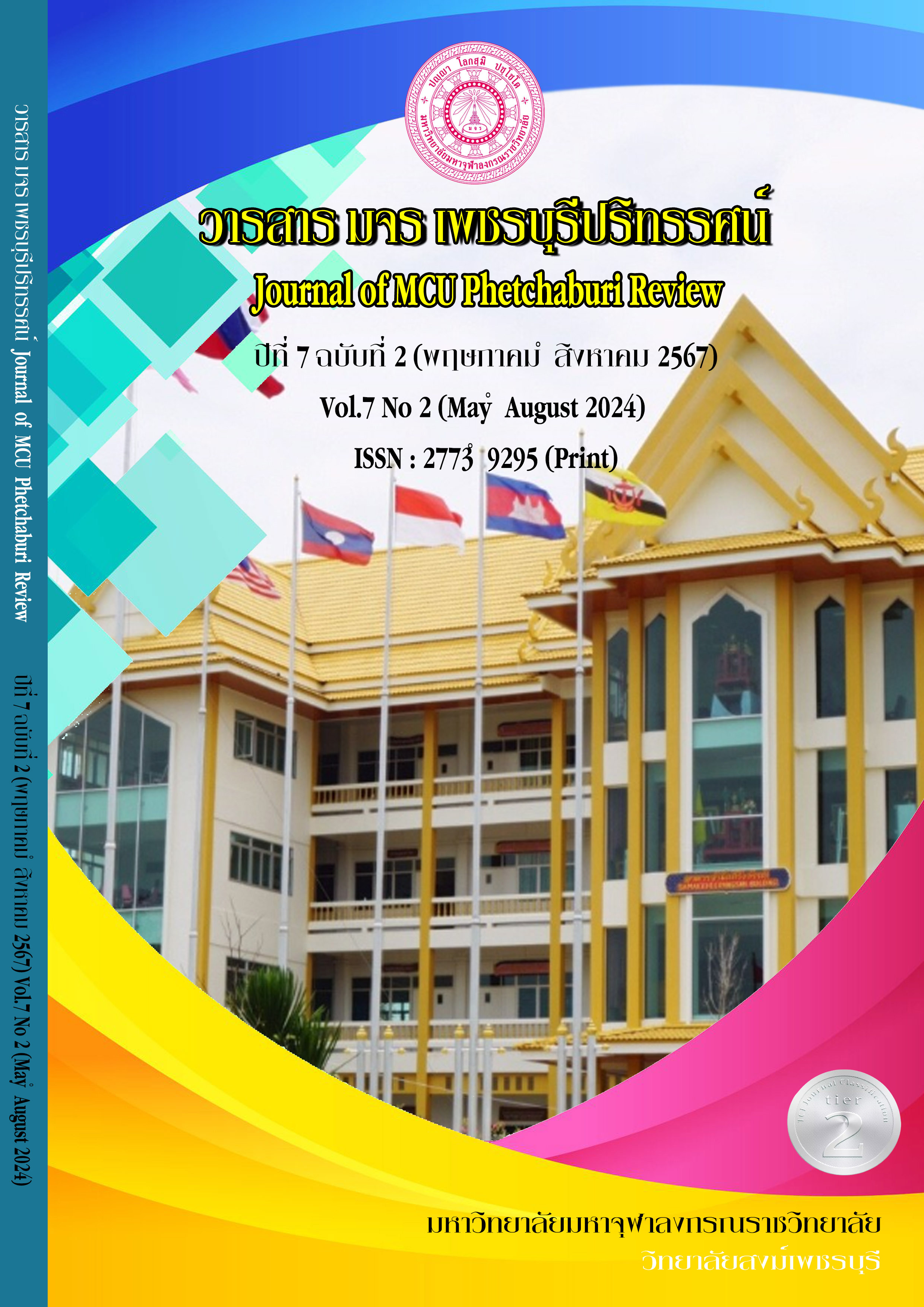Development of Business Model and E-Marketplace System for NFT Art
Main Article Content
Abstract
This research aimed to explore various aspects: 1) studying user requirements in NFT Marketplace platforms, 2) developing a business model for NFT Art Marketplace, 3) evaluating the developed business model for NFT Art Marketplace, 4) creating a prototype NFT Art Marketplace, and 5) assessing the efficiency of the NFT Art Marketplace prototype. This study involved 33 artists, 33 collectors, and 3 business model experts. Using both qualitative and quantitative approaches such as interviews and surveys, data analysis included typological analysis, percentages, means, and standard deviations. The findings are as follows: Firstly, the user requirements for NFT Marketplace platforms reveal that users are primarily interested in services and features that facilitate easier buying and selling of NFT. The major issues encountered are related to copyright infringement, impacting the transactions of NFT art. The proposed improvements or additional features aimed at enhancing the user experience on the NFT Marketplace include the implementation of a copyright infringement check for NFT and the addition of features to further streamline and improve the ease of buying and selling NFT. Secondly, the assessment of the NFT Art Marketplace business model revealed a highly positive Value Proposition Assessment, moderately positive Cost/Revenue Assessment, Infrastructure Assessment, Customer Interface Assessment, a moderate Threat Assessment, and a high Business Opportunity Assessment. Thirdly, the evaluation of the prototype NFT Art Marketplace indicated that among artists, there was a high perceived usefulness, high perceived ease of use, and high behavioral intention to use. Among collectors, perceived usefulness was high, perceived ease of use was high, and behavioral intention to use was high.
Article Details

This work is licensed under a Creative Commons Attribution-NonCommercial-NoDerivatives 4.0 International License.
References
กัลยา วานิชย์บัญชา. (2545). หลักสถิติ (พิมพ์ครั้งที่ 7). โรงพิมพ์จุฬาลงกรณ์มหาวิทยาลัย.
ขจีนุช สวัสดินาม. (2560). ปัจจัยที่มีผลต่อความไว้วางใจตลาดกลางพาณิชย์อิเล็กทรอนิกส์ในประเทศไทย [วิทยานิพนธ์ปริญญามหาบัณฑิต, มหาวิทยาลัยศิลปากร]. DSpace. http://ithesis-ir.su.ac.th/dspace/bitstream/123456789/1692/1/59602306 .pdf
จุฬารัตน์ แสงอรุณ. (2564). การพัฒนาแบบจำลองธุรกิจเชิงกลยุทธ์ของธุรกิจอาหารเพื่อสุขภาพจากเห็ดเยื่อไผ่. วารสารวิทยาลัยดุสิตธานี, 15(2), 208-226. https://dtc.ac. th/wp-content/uploads/2021/08/14.-การพัฒนาแบบจำลองธุรกิจเชิงกลยุทธ์...จุฬารัตน์...pdf
ชุมแพร บุญยืน, นวรัตน์ เดชพิมล, ณุกานดา ศุภวัฒน์, และศิรินนา วอนเก่าน้อย. (2561). ทฤษฎีการยอมรับการใช้เทคโนโลยีสารสนเทศ. วารสารช่อพระยอม, 29(1), 359-372. https://so01.tci-thaijo.org/index.php/ejChophayom/article/view/126470/ 95584
นพวรรณ เพ็ชรวงศ์. (2565). อิทธิพลของความมีน่าเชื่อถือ คุณภาพของเว็บไซต์ OpenSea ความมีชื่อเสียงของศิลปิน และคุณภาพของผลงานศิลปะในรูปแบบ NFT ที่ต่อความตั้งใจซื้อบนเว็บไซต์ OpenSea [วิทยานิพนธ์ปริญญามหาบัณฑิต, มหาวิทยาลัยมหิดล]. CMMU Digital Archive. https://archive.cm.mahidol.ac.th/handle/12345678 9/4573
นวรัตน์ ช่วยบุญชู, อรจันทร์ ศิริโชติ, และเจษฎา นกน้อย. (2562). การยอมรับเทคโนโลยีและคุณภาพการบริการที่มีอิทธิพลต่อความจงรักภักดีของผู้ใช้บริการธนาคารอิเล็กทรอนิกส์. วารสารเศรษฐศาสตร์และบริหารธุรกิจ มหาวิทยาลัยทักษิณ, 11(1), 31-52. https://so01.tci-thaijo.org/index.php/ecbatsu/article/view/178378/ 136243
ปภานัน วงศ์กิตติชัยกุล. (2562). ปัจจัยที่ส่งผลต่อการใช้งาน Krungthai NEXT ของกลุ่มวัยสีเงินในกรุงเทพมหานคร [วิทยานิพนธ์ปริญญามหาบัณฑิต, มหาวิทยาลัยศิลปากร]. DSpace. http://ithesis-ir.su.ac.th/dspace/bitstream/123456789/2868/1/ 61602341.pdf
ปราณปรียา ดาวศิริโรจน์. (2565). การศึกษาวิจัยการยอมรับเทคโนโลยีที่ส่งผลต่อการตัดสินใจลงทุน Gamefi ของผู้บริโภคกลุ่มสังคมออนไลน์ในประเทศไทย [วิทยานิพนธ์ปริญญามหาบัณฑิต, มหาวิทยาลัยมหิดล]. CMMU Digital Archive. https://archive.cm. mahidol.ac.th/handle/123456789/4763
ไปรมา อิศรเสนา ณ อยุธยา และชูจิต ตรีรัตนพันธ์. (2560). การคิดเชิงออกแบบ : เรียนรู้ด้วยการลงมือทำ. http://resource.tcdc.or.th/ebook/Design.Thingking.Learning. by.Doing.pdf
ภานุพงศ์ เสกทวีลาภ. (2557). ปัจจัยที่ส่งผลต่อความตั้งใจด้านพฤติกรรมการใช้ Cloud Storage ในระดับ Software-as-a-Service (SaaS) ของพนักงานองค์กรเอกชนในเขตพื้นที่เศรษฐกิจของกรุงเทพมหานคร [วิทยานิพนธ์ปริญญามหาบัณฑิต, มหาวิทยาลัยกรุงเทพ]. DSpace. http://dspace.bu.ac.th/bitstream/123456789/1261/1/ phanuphong.sekt.pdf
ลัดดาวัลย์ เพชรโรจน์, และอัจฉรา ชำนิประศาสน์. (2547). ระเบียบวิธีวิจัย Research Methodology. พิมพ์ดีการพิมพ์ จำกัด.
พาทินนุช วราศรัย. (2565). ปัจจัยที่ส่งผลต่อความพึงพอใจในการซื้อผลงานศิลปะในรูปแบบ NFT ผ่านแพลตฟอร์มออนไลน์ในประเทศไทย [วิทยานิพนธ์ปริญญามหาบัณฑิต, มหาวิทยาลัยมหิดล]. CMMU Digital Archive. https://archive.cm.mahidol.ac. th/handle/123456789/4543
วัชราวรรณ โทนประยูร, โชษิตา พุ่มห้วยรอบ, พัชรี รุ่งวรโศภิต, พัชระพงศ์ ร่มพฤกษ์ และนิภา นิรุตติกุล. (2565). ปัจจัยในการรับรู้ความง่ายในการใช้งาน การรับรู้ความเสี่ยง ความปลอดภัยและความไว้วางใจที่ส่งผลต่อการตัดสินใจเข้าสู่ตลาด NFT Game (Non-Fungible Token) ในกลุ่มผู้บริโภค Generation Y. วารสารศิลปศาสตร์และอุตสาหกรรมบริการ, 5(2), 134-149. https://so01.tci-thaijo.org/index.php/ JLASI/article/view/256240
ศุภวิชญ์ กุลเวชกิจ. (2565). การศึกษาวิจัยการจัดการความรู้ที่ส่งผลต่อการตัดสินใจลงทุนในเกมส์ Non-Fungible Token (NFT) ของคนในเขตกรุงเทพมหานครและปริมณฑล [วิทยานิพนธ์ปริญญามหาบัณฑิต, มหาวิทยาลัยมหิดล]. CMMU Digital Archive. https://archive.cm.mahidol. ac.th/handle/123456789/4765
สำนักงานคณะกรรมการกำกับหลักทรัพย์และตลาดหลักทรัพย์. (2565). Non-Fungible Token (NFT) และกำกับดูแลของ ก.ล.ต.. https://www.sec.or.th/TH/Template3 /Articles/2565/060165.pdf
สิงหะ ฉวีสุข, และสุนันทา วงศ์จตุรภัทร. (2555). ทฤษฎีการยอมรับการใช้เทคโนโลยีสารสนเทศ. KMITL Information Technology Journal. http://www.it.kmitl.ac. th/~journal/index.php/main_journal/article/view/2/4
อาภากร นพรัตยาภรณ์. (11 เมษายน 2565). โลกของ NFTs กับบทบาทของธนาคาร. Research Intelligence | Krungsri Research. https://www.krungsri.com/th/ research/research-intelligence/NFT
เอื้อมพร หลินเจริญ. (2555). เทคนิคการวิเคราะห์ข้อมูลเชิงคุณภาพ. วารสารการวัดผลการศึกษา, 17(1), 17-29. https://elfar.ssru.ac.th/peerapol_ch/pluginfile.php/ 33/block_html/content/การวิเคราะห์ข้อมูลเชิงคุณภาพ.pdf
อรพัทธ์ วงศาโรจน์. (2565). Non-Fungible Token และการคุ้มครองตามกฎหมายไทย. วารสารกฎหมายนิติพัฒน์ นิด้า, 11(1), 35-51. https://so04.tci-thaijo.org/index. php/nitipat/article/view/259298/175758
อลงกรณ์ วรรณธะนะ. (2565). ปัญหาการคุ่มครองลิขสิทธิ์ในงานสินทรัพย์ดิจิทัลที่มีลักษณะเฉพาะตัว (NFT: Non-Fungible Token). [วิทยานิพนธ์ปริญญามหาบัณฑิต, มหาวิทยาลัยกรุงเทพ]. DSpace. http://dspace.bu.ac.th/jspui/bitstream/12345 6789/5261/3/alongkorn_want.pdf
Astra Studio. (2022). The NFT Marketplaces you should consider selling NFT. Retrieved May 14, 2022, from https://astrastudio.digital/blog/nft-market places-compare
Davis, F. (1985). A Technology Acceptance Model for Empirically Testing New End-user Information Systems: Theory and Results [Doctoral dissertation, Wayne State University]. MIT Libraries. https://dspace.mit.edu/handle/ 1721.1/15192
Foundation. (2024). NFT Marketplace Platform. Retrieved January 5, 2024, from https://foundation.app/
LooksRare. (2024). NFT Marketplace Platform. Retrieved January 5, 2024, from https://looksrare.org/
NonFungible.com. (2022). Yearly NFT Market Report 2021. Retrieved February 10, 2023, from http://nonfungible .com/reports
OpenSea. (2024). NFT Marketplace Platform. Retrieved January 5, 2024, from https://opensea.io/
Rarible. (2024). NFT Marketplace Platform. Retrieved January 5, 2024, from https://rarible.com/
Rogers, E. M. (2003). Diffusion of Innovation (5th ed.). Free Press.
Strategyzer. (2023). The Business Model Canvas. Retrieved February 10, 2023, from https://www.strategyzer .com/canvas/business-model-canvas
SuperRare. (2024). NFT Marketplace Platform. Retrieved January 5, 2024, from https://superrare.com/


